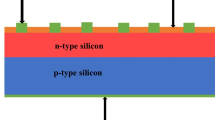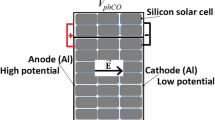Abstract
The temperature dependences of the efficiency η of high-efficiency solar cells based on silicon are calculated. It is shown that the temperature coefficient of decreasing η with increasing temperature decreases as the surface recombination rate decreases. The photoconversion efficiency of high-efficiency silicon-based solar cells operating under natural (field) conditions is simulated. Their operating temperature is determined self-consistently by simultaneously solving the photocurrent, photovoltage, and energy-balance equations. Radiative and convective cooling mechanisms are taken into account. It is shown that the operating temperature of solar cells is higher than the ambient temperature even at very high convection coefficients (~300 W/m2 K). Accordingly, the photoconversion efficiency in this case is lower than when the temperature of the solar cells is equal to the ambient temperature. The calculated dependences for the open-circuit voltage and the photoconversion efficiency of high-quality silicon solar cells under concentrated illumination are discussed taking into account the actual temperature of the solar cells.
Similar content being viewed by others
References
M. A. Green, Prog. Photovolt.: Res. Appl. 17, 183 (2009).
A. Jano, S. Tohoda, K. Matsuyama, Y. Nakamura, T. Nishiwaki, K. Fujita, M. Taguchi, and E. Maruyama, in Proceedings of the 28th European Photovoltaic Solar Energy Conf. and Exhibition, Paris, France, Sept. 30–Oct. 4, 2013 (2013), p. 1846.
A. V. Sachenko, A. I. Shkrebtii, R. M. Korkishko, V. P. Kostylyov, N. R. Kulish, and I. O. Sokolovskyi, Semiconductors 49, 264 (2015).
Yu. V. Kryuchenko, A. V. Sachenko, A. V. Bobyl, V. P.Kostylyov, P. N. Romanets, I. O. Sokolovskyi, A. I. Shkrebtii, and E. I. Terukov, Semicond. Phys. Quant. Electron. Optoelectron. 15, 91 (2012).
Yu. V. Kryuchenko, A. V. Sachenko, A. V. Bobyl, V. P. Kostylyov, I. O. Sokolovskyi, E. I. Terukov, V. N. Verbitskii, and Yu. A. Nikolaev, Tech. Phys. 58, 1625 (2013).
A. V. Sachenko, V. P. Kostylyov, N. R. Kulish, I. O. Sokolovskyi, and A. I. Shkrebtii, Semiconductors 48, 675 (2014).
D. G. Kröger, Res. Developm. J. 18, 49 (2002).
A. V. Sachenko, A. P. Gorban, V. E. Kostylyov, and I. O. Sokolovskyi, Semiconductors 40, 884 (2006).
A. P. Gorban, V. P. Kostylyov, V. N. Borschev, and A. M. Listratenko, Telecommun. Radio Eng. 55 (9), 94 (2001).
http://solar-front.livejournal.com/11644.html
www.sunpowercorp.com/datasheets, X-series datasheets
R. G. Ross, and M. I. Smokler, Flat-Plate Solar Array Project, Vol. 6: Engineering Sciences and Reliability (Jet Propulsion Lab. California Inst. of Tech., Pasadena, CA, 1986).
Author information
Authors and Affiliations
Corresponding author
Additional information
Original Russian Text © A.V. Sachenko, A.I. Skrebtii, R.M. Korkishko, V.P. Kostylyov, N.R. Kulish, I.O. Sokolovskyi, 2016, published in Fizika i Tekhnika Poluprovodnikov, 2016, Vol. 50, No. 4, pp. 531–537.
Rights and permissions
About this article
Cite this article
Sachenko, A.V., Skrebtii, A.I., Korkishko, R.M. et al. Simulation of the real efficiencies of high-efficiency silicon solar cells. Semiconductors 50, 523–529 (2016). https://doi.org/10.1134/S1063782616040205
Received:
Accepted:
Published:
Issue Date:
DOI: https://doi.org/10.1134/S1063782616040205




